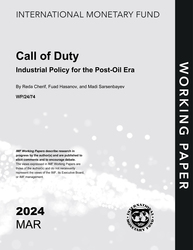
Call of Duty: Industrial Policy for the Post-Oil Era
Call of Duty: Industrial Policy for the Post-Oil Era
READ MORE...
Volume/Issue:
Volume 2024
Issue 074
Publication date: March 2024
ISBN: 9798400270994
$20.00
Add to Cart by clicking price of the language and format you'd like to purchase
Available Languages and Formats
| English |
Prices in red indicate formats that are not yet available but are forthcoming.
Topics covered in this book
This title contains information about the following subjects.
Click on a subject if you would like to see other titles with the same subjects.
Exports and Imports , Economics- Macroeconomics , Economics / General , Environmental Conservation and Protection , Diversification , Industrial Policy , Energy Transition , Oil Exporters , policy continuity , growth recipe , oil exporter , sector selection strategy , IMF working paper 24/74 , b , sector selection analysis , Oil exports , Exports , Oil prices , Global
Also of interest
Summary
Oil-exporting economies face the risk of an acceleration in the energy transition. A risk-based approach calls for urgent preparation for the post-oil era by diversifying exports and transforming the prevailing growth model. We outline the principles of industrial policy to achieve this objective based on the experience of the Asian Miracles and propose a sketch of the strategy required to transform these principles into practice. The key component of the strategy is to select sectors along two dimensions—proximity to the current production structure or capabilities set and a timeframe for results to materialize. The three strategies—snail crawl, leapfrogging, and moonshots—determine how far from the current production structure the selected sectors are. These sectors need to show results both in the short run to jumpstart growth and ensure policy continuity—“quick wins”—and the long run to create a new growth model—“transformative gains.” We argue that the strategy should focus on supporting the exports of sophisticated sectors in both manufacturing and services while capitalizing on complex tasks and activities in existing industries but should leave non-sophisticated sectors such as tourism and non-tradable services to the private sector.
Copyright © 2010 - 2026
Powered by:
AIDC



